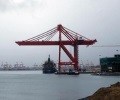Maritime sulfur cap could crimp container port volumes

IMO 2020 emissions cap to have unknown impact on container lines, international shippers, Drewry says.
Ocean cargo carriers will probably be able to recoup the costs of a new cap on sulphur emissions beginning in 2020, but the change still presents enough risk that a new report has downgraded its forecast for the growth rate of world container port volumes for the current year and the rest of the five-year horizon.
Global port throughput is now forecast to rise by 2.6% in 2019, down from the previous 3.0% expectation, according to Drewry Shipping Consultants’ “Container Market Annual Review and Forecast 2019/20.”
London-based Drewry stated that one of the major risks to the sector is the impact of IMO 2020 on containership supply. The International Maritime Organisation (IMO) has ruled that marine sector emissions in international waters must be reduced by over 80% starting on Jan. 1, 2020, according to the research and consultancy business Wood Mackenzie.
The IMO says it levied the regulation in order to slash ships’ emissions of sulphur oxides (SOX), a family of pollutants which are known to be harmful to human health—causing respiratory symptoms and lung disease—and to degrade environmental air quality, leading to acid rain that harms crops, forests, and aquatic species.
The group has targeted ocean freight because the marine sector, which consumed 3.8 million barrels per day of fuel oil in 2017, is responsible for half of global fuel oil demand, Wood Mackenzie said.
The implications of the new regulation are likely to send ripples throughout the global supply chain. Shipping lines must now decide whether to clear the hurdle through strategies like improved engine technology, slow steaming, exhaust scrubbers, or low-sulphur fuels. At the same time, shippers expect that they will have to pay more, as carriers pass along the higher costs.
Facing that array of options, there is still no clear guidance on just how much additional cost will land on the shipping industry itself, Drewry said. In addition, tumultuous current events such as the recent drone attacks on Saudi oil facilities have caused oil prices to spike, further muddying the waters.
Drewry’s current estimate is that vessel operators will next year be faced with an additional $11 billion fuel bill related to the switchover to low-sulphur fuel oil, and the degree of compensation that carriers receive will dictate the level of supply disruption next year. “Our working assumption is that carriers will have more success in recovering that cost than previously, to the point that there will be no major disruption to supply,” Simon Heaney, senior manager, container research at Drewry and editor of the Container Forecaster, said in a release.
“However, if they fall short by a significant margin, we think that lines would quickly dust off the decade-old playbook that was used to see them through the global financial crash,” Heaney said. “There will be much less focus by carriers on service quality and more on cost cutting. In that scenario, carriers will try to protect cash flows by restricting capacity as best they can, through a combination of measures, including further slow-steaming, more blank sailings, and off-hiring of chartered vessels.”
In Drewry’s assessment, failure to recover more of that larger fuel bill would also be likely to push more carriers and owners to either have more ships fitted with exhaust scrubbers (to be able to continue running on the cheaper high-sulphur oil) and/or to ramp-up demolitions.
“If events follow this path the supply-demand balance will look very different from our current forecast. The worst case scenario, when most shipping lines cannot operate close to breakeven and some potentially face bankruptcy, would actually be a far quicker route to rebalancing the market than the current plodding track,” said Heaney. “It would take a very brave carrier to want such a turn of events, but for those that could be sure of coming through the other side, after some initial pain the rewards would be far greater.”
Source: Supply Chain Quarterly

 Hellenic Shipping News Worldwide Hellenic Shipping News Worldwide, Online Daily Newspaper on Hellenic and International Shipping
Hellenic Shipping News Worldwide Hellenic Shipping News Worldwide, Online Daily Newspaper on Hellenic and International Shipping






















 PG-Software
PG-Software